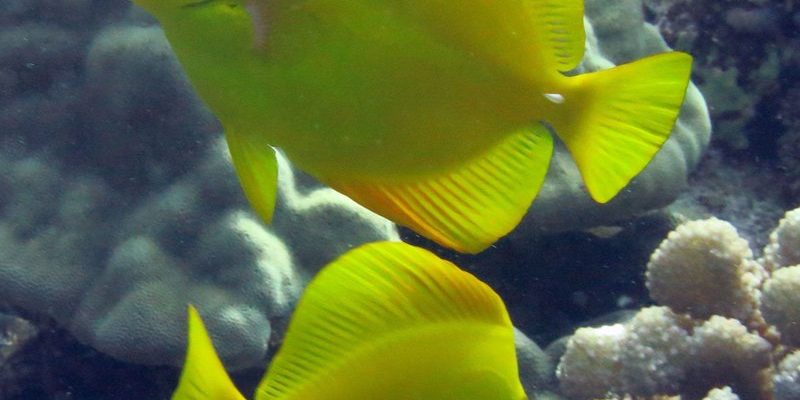![Yellow Tang Vs. [Similar Species] - Key Differences](https://gudri.com/wp-content/uploads/2025/06/Yellow_Tang_Vs___Similar_Species______Key_Differences_image_0.jpg)
Think of the yellow tang as the sunniest character in a buddy comedy. It’s lively, social, and always brings a splash of color. But there are other fish out there with similar charm and appeal that might fit into your marine setup just as well—or better! Understanding the key differences can not only help you choose the right fish, but it can also lead to a healthier and more harmonious aquarium environment.
What Is a Yellow Tang?
The yellow tang, scientifically known as *Zebrasoma flavescens*, hails from the warm waters of the Pacific Ocean, particularly around Hawaii. These fish are known for their bright yellow coloration, which is not just a fashion statement. The vibrant hue serves as a form of communication in the wild. Essentially, it’s like wearing a “Hey, look at me!” sign to attract mates or warn off potential threats.
In terms of size, yellow tangs can grow up to about 8 inches, though many stay smaller in home aquariums. They’re herbivores, primarily munching on algae, so if you plan to keep one, you’ll need to ensure plenty of greens are available in the tank. You might be wondering, *Are they easy to care for?* Generally, yes! They adapt well to aquarium life, but like any fish, they have specific needs that you should be aware of.
Similar Species: The Purple Tang
Now, let’s look at the purple tang (*Zebrasoma xanthurum*), which often gets tossed around in the same conversations as the yellow tang. The purple tang is striking in its own right, sporting a deep purple hue that can add a different dimension to your aquarium. But don’t let the color fool you; these two species have different personalities and care requirements.
One of the key differences is behavior. While yellow tangs are known for their generally peaceful demeanor, purple tangs can sometimes be a bit more territorial, especially in smaller tanks. If you’re considering adding one to your setup, think about how it might interact with your existing fish. You wouldn’t want a fish brawl breaking out over territory!
Care Requirements Comparison
When it comes to caring for yellow tangs and purple tangs, their requirements overlap, but there are nuances worth noting.
- Diet: Both fish are herbivores, but yellow tangs prefer a diet high in algae, while purple tangs can be a bit more flexible, consuming prepared foods as well.
- Tank Size: Yellow tangs thrive in larger tanks (at least 75 gallons), while purple tangs can manage in slightly smaller setups, but they do appreciate space to swim.
- Water Conditions: Both species require similar water parameters—warm, clean water with stable salinity levels—but purple tangs may be less forgiving to fluctuations.
Maintaining a tank that meets these needs can be a bit of a balancing act, but understanding these differences can set you up for success.
Behavior and Social Dynamics
Behavior is another area where yellow tangs and purple tangs diverge. Yellow tangs are famously social fish. They often enjoy the company of their own kind and can usually coexist with other peaceful fish without much fuss. You might even catch them grazing together, forming a little community.
On the other hand, purple tangs can exhibit a more aggressive nature, particularly toward other tangs. They can be a bit of a lone wolf in the tank, so introducing them into a community tank may require some careful planning. If you’re thinking about keeping both species in one tank, it’s wise to introduce them simultaneously to level the playing field.
Appearance: More Than Just Color
While both yellow and purple tangs are stunning, their appearances go beyond just color.
– Body Shape: Both species have a similar body shape, which is typical for tangs. They’re oval and laterally compressed, designed for swift swimming.
– Fin Features: The yellow tang has a longer dorsal fin that can stand upright when threatened, while the purple tang sports a more subtle dorsal fin structure.
These differences may seem minor, but if you’ve got a trained eye, they can be quite noticeable. Plus, these features can affect how the fish navigate around obstacles in your aquarium.
Compatibility with Other Fish
One of the most critical factors to consider when adding fish to your tank is compatibility. Since yellow tangs are generally more peaceful, they can often coexist with a variety of species, making them a favorite among beginners. They can thrive with clownfish, gobies, and even peaceful wrasses.
In contrast, purple tangs, with their more territorial nature, can sometimes be a bit more difficult to pair with other fish. They might pick on new arrivals, especially if those newcomers are similar in shape or size. If you go this route, introduce fish gradually and provide plenty of hiding spots to alleviate any stress.
Final Thoughts: Which One Is Right for You?
Ultimately, choosing between a yellow tang and a similar species like the purple tang depends on your aquarium setup, your experience level, and what you’re looking for in terms of fish personality. If you want a brightly colored, social fish that gets along with most communities, the yellow tang is a fantastic choice. However, if you’re drawn to striking colors and a slightly more challenging fish, the purple tang might be your pick.
Whatever you decide, understanding the key differences will lead to a happier, healthier aquarium. Happy fishkeeping!

